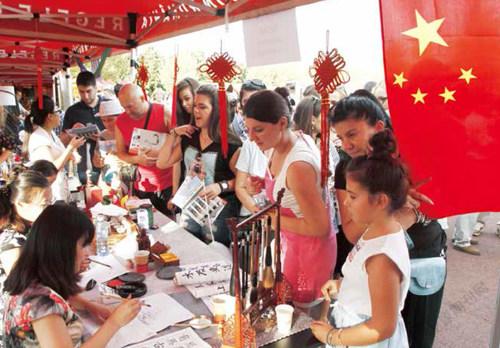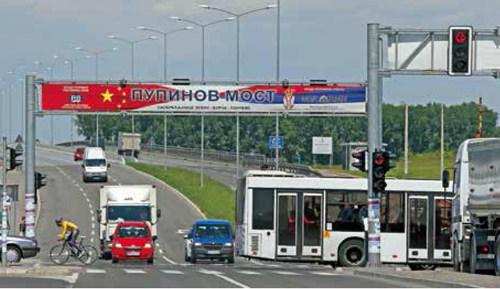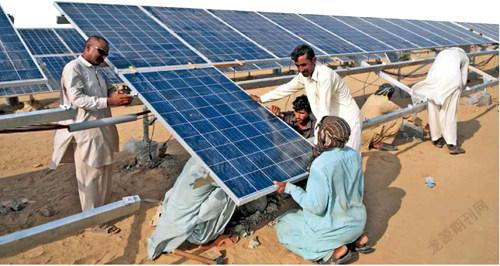民心相随 共筑“—带一路”合作基石
莫小阡

2015年,在罗马尼亚举行的首届大使馆节上,人们在中国展台等待领取写着自己中文名字的书法作品(新华社 供图)
“国之交在于民相亲,民相亲在于心相通。”2013年,“丝绸之路经济带”和“21世纪海上丝绸之路”的提出,构建起新的历史进程下延展的共同发展之路。几年间,项目合作全面开花,在“一带一路”沿线不断落地落实,推动着互联互通的完善,作为“一带一路”建设人文基础的民心相通领域,也交出了优异的“成绩单”。
从中共中央对外联络部当代世界研究中心联合中国人民大学重阳金融研究院共同编写的《“一带一路”民心相通报告》中不难看出,民心相通建设成果,为“一带一路”建设奠定了良好的民意基础。
几年来,中国同“一带一路”建设参与国广泛开展人文交流与合作,规划实施了一大批品牌项目和活动;
中国政府每年向相关国家提供1万个政府奖学金名额,地方政府也设立了丝绸之路专项奖学金,为沿线国家培养了大量行业领军人才和优秀技能人才;
中国与相关国家互办文化年、旅游年、艺术节、电影节、电视周、图书展等,推动各国展现各自民族特色,感受不同文化风采,增进相互了解认知;
另外,科技、教育、文化、卫生、旅游、智库、青年、城市、社会组织等各领域合作,不断拓展交流宽度、增强交流深度……
一项项促进民心相通的交流融通离不开顶层设计的推动。
2016年,教育部牵头制订了《推进共建“一带一路”教育行动》,旨在深化“一带一路”沿线国家教育领域的合作,扩大人文交流,加强人才培养。为此,我国开展了“一带一路”教育法律、政策协同研究,构建沿线各国教育政策信息交流通报机制,为沿线各国政府推进教育政策互通提供决策建议,为沿线各国学校和社会力量开展教育合作交流提供政策咨询。积极签署双边、多边和次区域教育合作框架协议,制定沿线各国教育合作交流国际公约,逐步疏通教育合作交流政策性瓶颈,实现学分互认、学位互授联授,协力推进教育共同体建设。
2017年,“一带一路”暨“健康丝绸之路”高级别研讨会在北京召开,会议对建设“健康丝绸之路”进一步规划:成立“一带一路”卫生政策研究网络,促进“一带一路”沿线国家在重大传染性疾病的监测、防控和应对方面的协调和合作;开展对口医院合作,通过“光明行”“微笑行”等短期义诊及捐献药械等多种形式,向“一带一路”国家提供卫生援助;促进传统医药政策、技术、研发和人员交流;鼓励医学科研机构间合作,在前沿医学科技、重大疾病防治、疫苗研发、临床研究等领域开展联合研究和技术攻关;支持发展健康服务贸易、健康医疗旅游和养生保健,探讨“一带一路”国家相关药械准入标准互认等合作。
另外,我国与“一带一路”相关国家的文化交流与合作机制也日益完善。20T6年底,我国已经和“一带一路”相关64个国家签订了政府间文化交流合作协定。文化部发布的《文化部“一带一路”文化发展行动计划(2016-2020年)》提出,要建成“一带一路”文化交流合作机制,完善“一带一路”文化交流合作平台,打造“一带一路”文化交流品牌,推动“一带一路”文化产业繁荣发展,促进“一带一路”文化贸易合作,为民心相通的实现提供强有力的支撑。
与此同时,我国还与“一带一路”相关国家建立了各种区域性对话机制,如上海合作组织成员国文化部长会晤、中国—中东欧国家文化合作部长论坛、中阿文化部长论坛等。
在多种要素的共同着力下,民心相通的种子已经播撒到“一带一路”沿线国家。
在广泛开展人文交流与合作的同时,以教育促进文明互鉴,以智慧增进彼此了解也成为巩固民心相通成果的重要领域。
近年来中国政府奖学金吸引力不断提升,奖学金向周边国家和“一带一路”相关国家倾斜,成为国家战略人才和人脉储备的重要渠道。据教育部统计数据显示,2017年共有来自204个国家和地区的各类留学人员在全国31个省、自治区、直辖市的935所高等院校学习,其中硕士和博士研究生共计约7.58万人,比2016年增加18.62%。“一带一路”相关国家留学生31.72万人,占总人数的64.85%。另一方面,据不完全统计,中国科研机构和高等院校的“一带一路”研究平台达300家,参与“一带一路”研究的外国知名智库已有50多家。目前,中国智库出版了400多本“一带一路”相关图书,国外知名智库发表了100多份专题研究报告。
在出版、影视剧翻译方面,我国已经与“一带一路”相关「6个国家和地区签订了互译出版协议,翻译出版了近100种优秀图书,与15个国家签订了电影合拍协议,与一些国家签订了电视合拍协议。很多中国现象级影片正被翻译成各国语言,在“一带一路”沿线国家播放,通过这些影片,中国的形象也愈加立体起来。
近些年,随着中国人民生活水平的日益增长,旅游的开支占比正成为国人收入支配的重要部分,而“一带一路”相关旅游资源极其丰富,拥有近500项世界自然和文化遗产,成为国人旅游热门地。截至2018年1月3日,持普通护照中国公民可以免签、落地签前往的国家和地区,增加到67个。根据国家旅游局数据显示,2017年全年中国公民出境旅游人数13051万人次,比上年同期增长7.0%。中国已连续多年保持世界第一大出境旅游客源国地位。
往来之间,不同领域的民心相通为“一带一路”的建设积累起了源源不断的内生动力。企业自觉担当
《“一带一路”民心相通报告》中特别指出,中国企业在“走出去”过程中唱响“融”字主旋律,主動融入当地社会,积极担当起民心相通的责任。日前,在国务院国资委举行的中央企业参与“一带一路”建设媒体通气会上,国资委副主任、党委委员翁杰明也介绍道,“一带一路”建设有效带动了所在国当地就业。数据显示,央企大力推进本土化经营,海外分支机构85%是本地员工,不少企业员工本地化率达到90%以上,中国石油印尼公司、中国移动巴基斯坦公司员工本地化率高达gg%。在直接提供就业岗位的同时,还间接带动了十几倍甚至几十倍的当地就业。
企業在促进当地经济发展的同时,严格遵守国际通行规则和当地环保法律法规,通过开展第三方环境评估、节能减排、废弃物管理等,加大对环境的保护力度。积极履行社会责任,开展爱心公益活动,帮助解决当地民众的实际困难。随着项目的落成,有些地区改变了落后的现状,有的则改变了多年的生活习惯。
在老挝万荣水电十四局项目部的办公室里,一张张老挝万象省万荣县村民质朴的笑脸在电脑屏幕上闪现,这些村民终于用上自来水了。曾经,村里人喝的是浑浊的、微生物超标的水,现在,村里245户人家,1225人,家家都用上了自来水,村上学校的师生也有了安全饮用水。万荣县副县长为此专程来到项目部,给建设者们送上感谢信和一份沉甸甸的荣誉证书。
这只是因项目建设改变当地现状的一个缩影,中国交建仅在肯尼亚蒙内铁路建设期间,就为当地居民打了100多口深水井,赢得了肯尼亚民众的认可;中国电建多次组织参与项目当地道路修复、沉船搜救、车祸处理等抢险救灾行动;中冶集团在项目所在地出资建设医院、学校,赢得了当地社会和居民的广泛赞誉……

由中企承建的塞尔维亚贝尔格莱德普平大桥
在“一带一路”建设过程中,参与者们书写了太多值得赞颂的友谊新篇章,描绘了太多民心相通的时代新画卷。

中巴经济走廊优先实施项目之一的中兴能源900兆光伏地面电站(本版图片/新华社 供图)
Chinese President Xi Jinping once said,“Friendship, which derives from close contactbetween the people, holds the key to sound state-to-state relations.” In 2013, he proposed the initiative ofthe Silk Road Economic Belt and the 2lst-CenturyMaritime Silk Road, providing a way for comrmondevelopment on a new historical joumey. Within justa couple of years, comprehensive progress has beenmade in cooperative prOJects carried out under theBelt and Road Initiative, givrng a continuous boost toregional connectivity. At the same time, remarkableachievements have also been made in people-to-people bonds, the cultural cornerstone of advancingthe Belt and Road Initiative.Leveraging top-level design as a driving force
It is clear that achievements lJl promoting people-to-people bonds have laid a sound foundationof popular will for advancing the Belt and RoadInitiative, as revealed by the Report offPeople-to-People Bonds under the Belt and Road Initiative byChina Center for Contemporary World Studies of theIntemational Department. Central Committee of theCommunist Party of China and Chongyang Institutefor Financial Studies, Renmin University of China.
Over the past years, China has made a long list ofachievements in promoting people-to-people bonds:China together with other participants of the Beltand Road has conducted extensive people-to-peopleexchanges and cooperation and implemented a host ofbrand projects and activities;
The Chinese government offers 10,000government scholarships each year to students fromB&R countries and China's local governments havealso set up special Belt and Road scholarships whichhave helped these countries train industrial leaders andskillful talented people;
China and relevant countries have held cultureyears. tourism years, arts festivals. film festivals.TV weeks and book fairs in each other's countries so as to highlight respective national and culturalcharacteristics and enhance mutual understanding;
In addition. cooperation in technology, education,culture,health care,tourism, think tank, the youth, cityand social organizations continues to extend for widerand deeper exchanges……
These endeavors to promote people-to-peoplebonds cannot be in place without the impetus fromtop-level design.
In 2016, the Ministry of Education formulatedthe Education Action Plan for the Belt and RoadInitiative in a bid to deepen education cooperation,broaden people-to-people exchanges and strengthen talent training among B&R countries. To this end,China has carried out studies on how to coordinatedomestic laws and policies with education amongB&R countries and put in place an education policyinformation sharing mechanism for these countries inan effort to provide decision-making advice to relevantgovernments on keeping education policies alignedand to offer policy consultation to schools and socialactors in these countries on educational cooperationand exchanges; China has redoubled efforts to reachbilateral. multilateral and sub-regional frameworkagreements for educational cooperation, formulateinternational convention on educational cooperationand exchanges among B&R countries and steadilybreak policy-related bottlenecks in educationalcooperation and exchanges, seeking to establish morearrangements to have academic credits to be mutuallyrecognized and more dual and joint degrees conferred,with the prospect of working concertedly to build anintegrated educational community.
In 2017, the Belt and Road High-1evel Meetingfor Health Cooperation: towards a Health Silk Roadwas held in Beijing, at which a more elaborate planfor “Health Silk Road” was formulated, including:establishing the Belt and Road Health PolicyResearch Network to push forward coordinationand cooperation among B&R countries in themonitoring, prevention and control, and responseto major infectious diseases; providing health aidto B&R countries through hospital cooperation,short-term free treatment. including treatment ofcataract and cleft lip and palate, and donation ofmedicines and medical devices; promoting policies,technology, R&D and personnel exchanges in thefield of traditional medicine among B&R countries;encouragmg cooperation between medical researchinstitutions and carrying out joint researches to maketechnological breakthrough in the fields of advancedmedical technology, major disease prevention andcontrol. vaccme research and development andclinical research; supporting the development ofhealth services trade,1Iledical and health care tourismand health preservation and exploring the cooperationon B&R countries’mutual recognition on drugs anddevices access standards.
In addition. China has also seen improvements inthe cultural exchanges and cooperation mechanismswith relevant B&R countries. By late 2016, Chinahad signed intergovemmental agreements on culturalexchanges and cooperation with 64 B&R countries.According to the Ministry of Culture’s Action Planon Belt and Road Culyure Development (2016-2020), China should develop the Belt and Roadcultural exchanges and cooperation mechanism,optimize the Belt and Road cultural exchanges andcooperation platform build the Belt and Road culturalcommunication brand. boom the Belt and Roadcultural industry and promote the Belt and Roadcultural trade cooperation so as to provide strongsupport for realizing people-to-people bonds.
Meanwhile, China has also set up diverseregional dialogue mechanisms with relevant B&Rcountries,including the Cultural Ministers' Meetingof the Member States of the Shanghai CooperationOrganization, China-CEEC Cultural CooperationForum and Cultural Ministers' Forum of China andArab States.
Thanks to the combined effects of multiplefactors,the seeds of people-to-people bonds have beensowed in B&R countries.Making progress in multiple fronts
While carrying out extensive people-to-peopleexchanges and cooperation, China has also made alot of efforts in facilitating mutual leaming througheducation and mutual understanding throughknowledge among the peoples of B&R countries,yielding fruitful results in people-to-people bonds.
In recent years, Clrina has opened up an importantchannel to pool national strategic talents and establishconnections by providing increasingly attractivescholarships and offering more scholarships toneighboring countries and relevant B&R countries.Statistical data from the Ministry of Education of PRCshows that 935 domestic higher education institutionsin 31 provinces, autonomous regions and municipalitiesreceived students from 204 countries and regionsin 2017. They included 75,800 postgraduates, anincrease of 18.62% compared t0 2016. The numberof sffldents from B&R countries has reached 317,200,accounting for 64.85% of all intemational students inChina. According to data available, Chinese researchinstitutions and universities have established morethan 300 research platforms under the Belt and RoadInitiative and more than 50 well-known foreign thinktanks have joined the research. And by far over 400books and 100 research reports on the initiative havebeen published by Chinese think tanks and their foreign COUnterparts respectively.
In the field of publishing and film and televisiontranslation, China has signed cooperation agreementswith 16 countries and regions along the Belt andRoad with nearly 100 kinds of excellent works havingbeen translated and published. In addition, China hassigned co-production agreements of films with 15countries, as well as co-production agreements of TVdramas with a number of countries. Many Chinesebox-office blockbusters are being translated intovarious languages and released in B&R countries,displaying China more vividly.
With ever-improving living standards over thepast few years, Chinese people are spending a higherportion of their disposable incomes on tourism.Countries and regions along the Belt and Road withrich tourism resources including nearly 500 worldnatural and cultural heritage sites, have become hotdestinations for Chinese travelers. As of January 3,2018, Chinese citizens had visa-free or visa on arrivalaccess t0 67 countries and territories. According to theChina National Tourism Administration, the numberof outbound tourists in China reached 130.51 millionin 2017,up 7.0% over the previous year. China hasmaintained the status of the world's largest customercountries of outbound travel for many years.
Such frequent exchanges and broad efforts inimproving the people-to-people bonds between Chinaand other B&R countries have stimulated internalimpetus to push the Belt and Road ahead.Chinese enterprises vigorously shoulder socialresponsibilities
It is highlighted in the Report on People-to-People Bonds under the Belt and Road Initiativethat Chinese enterprises are focusing efforts on“integration” when they go global. They are takingthe initiative to integrate into the local society andtaking on the responsibility of promoting people-to-people bonds. The other day, Weng Jienung, memberof the CPC Committee and Vice Chairman of State-owned Assets Supervision and AdministrationCommission (SASAC), said at the Press Conferenceof Central SOEs Participating in the Development ofthe Belt and Road Initiative that the Belt and Roadhas effectively promoted local employment in B&Rcountries. Data shows that Chinese central SOEs havemade great efforts in achieving localization. Locallabors account for 85% of the employees at overseasbranches of Chinese central SOEs and even for ashigh as 90% in many cases. In PetroChina Indonesiaand China Mobile Pakistan, local labors accountfor gg%. In addition to providing job opportunitiesdirectly, these central SOEs also bring a huge boostfor those regions ' employment indirectly.
While driving local economic growth, Chineseenterprises also strictly abide by internationallyrecognized rules and local laws and regulationson environmental protection. and increase effortsto protect the environment through third-partyenvironmental impact assessment, energy conservationand emission reduction, waste management, etc.Theyactively shoulder their social responsibilities and carryout charity activities to help locals out of difficulties.With the completion of relevant projects, some areaswith backward economy have made progress, andsome people have changed their bad living habits thathad been ingrained for many years.
In the project office of Sinohydro Bureau 14 Co.,Ltd. in Vang Vieng, Vientiane Province, Laos, smilesof local villagers flash on the computer screen, as theyhave eventually ended the history of drinking turbidwater with excessive microbes and gained access totap water. A11 0f the l,225 people in 245 households,including teachers and students in the village schoolhave had access to tap water and safe drinking water.To extend their gratitude, Deputy County Mayor ofVang Vieng paid a special visit to the project office tosend letters of thanks and a certificate of honor.
This is merely an epitome of the impressivechanges brought about by Chinese enterprises to localcommunities when implementing projects under theBelt and Road and there are scores of other examples.For instance, China Communications ConstructionCompany drilled more than 100 deep-water wellsfor local residents when constructing the Mombasa-Nairobi Railway in Kenya, winning the recognitionof Kenyan people; POWERCHINA has organizedand participated in many local rescue and reliefworks such as road rehabilitation, sunken ship searchand rescue, and dealing with car accidents; ChinaMetallurgical Group Corporation has funded theconstruction of local hospitals and schools, which iswidely acclaimed by local communities.
In the process of advancing the Belt and RoadInitiative, participants have written countless newchapters of friendship and people-to-people bonds.

